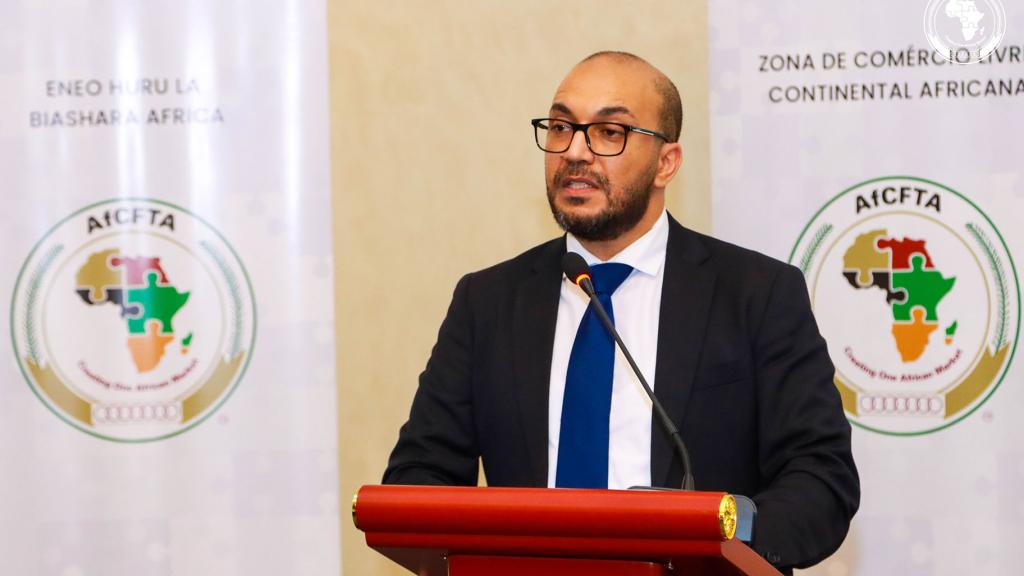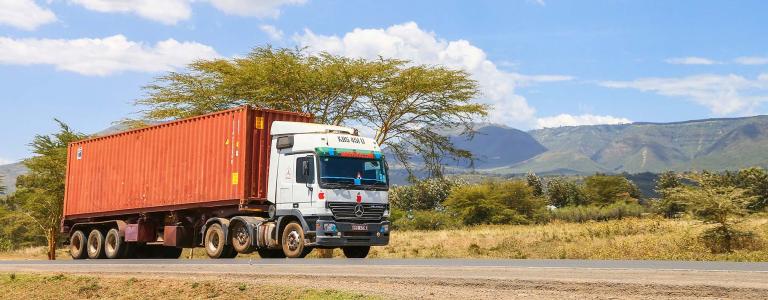AfCFTA’s Ali: Watch for More African Trade Thanks to Guided Trade Initiative
The long anticipated African Continental Free Trade Area (AfCFTA) is nearly up and running. Jennifer Freedman, managing editor of IISD’s Trade and Sustainability Review, details what must be done to finalize the guided trade initiative.
On your mark, get set, go! The race is on to get the long-delayed African Continental Free Trade Area (AfCFTA) fully up and running.
But the only way to reach this particular finish line is to wrap up negotiations on rules of origin—a key step for harmonizing rules and determining the nationality of products that will be traded across Africa under the AfCFTA. This is important to ensure that only genuine African goods benefit from tariff concessions and that these goods can actually be traded under the preferential AfCFTA regime.
AfCFTA signatories will phase out tariffs on 90% of goods by 2030 at the latest. They’ll get more time to scrap tariffs on 7% of goods that are considered sensitive, and the remainder will be excluded.
While at least 46 of the agreement’s 54 members have submitted tariff-reduction schedules, they’re still haggling over textiles and motor vehicles—which account for about 10% of the rules of origin. Product-specific rules in these sectors tend to be more restrictive, and their average preferential margins are twice the average in sectors where product-specific rules have already been approved.

Mohamed Ali, Director of Trade in Goods and Competition at the AfCFTA Secretariat, takes a cup-half-full approach to the rules of origin negotiations, noting that about 90% of them have been agreed. And, he says, the Secretariat has come up with a plan to nudge AfCFTA countries over the finish line.
The AfCFTA “is more than just tariff reductions; it enables investors to have access to that huge market which will attract investment, driven by rules of origin that prioritize African inputs and value-added goods and services.
“The Secretariat developed complementary strategies that mix trade policy elements and value chain development to fast-track the conclusion of the negotiation in the areas of automobiles and textiles,” Ali said in an interview. “Furthermore, the ministers responsible for trade recently agreed on the three protocols under Phase 2 of the AfCFTA negotiations: intellectual property rights, investment, and competition policy.”
He also notes that the AfCFTA “is more than just tariff reductions; it enables investors to have access to that huge market which will attract investment, driven by rules of origin that prioritize African inputs and value-added goods and services. Additionally, guided trade interventions allow us to promote the development of intra-African regional value chains in the key strategic areas, notably automotive, agro-processing, pharmaceuticals, and transportation and logistics.”
Five key instruments have been adopted to operationalize the agreement, Ali says. These are the Pan African Payment Settlement System; a monitoring mechanism for non-tariff barriers; the Africa Trade Observatory; the e-Tariff Book; and the AfCFTA Adjustment Fund to address anticipated short-term revenue losses. In addition, various enabling tools/regulations including the Rules of Origin Manual, customs documentation, and trade facilitation initiatives are in place to support AfCFTA implementation.
The start of trade under the agreement was delayed for months due to the COVID-19 pandemic. Even now, 2 years after Africa’s free trade area opened for business amid considerable fanfare, the launch is considered largely symbolic, with full implementation of the deal expected to take years. The AfCFTA still faces an array of challenges, from poor infrastructure and political unrest to excessive border bureaucracy and petty corruption—and the fact that 10 of the 54 signatories have yet to ratify the agreement.
GTI Aims to Kick-Start Intraregional Trade
Still, several African nations have finally begun to trade goods under the AfCFTA thanks to a new pilot project called the Guided Trade Initiative (GTI). Announced by AfCFTA Secretary General Wamkele Mene in July, the GTI supports traders in eight countries—Cameroon, Egypt, Ghana, Kenya, Mauritius, Rwanda, Tanzania, and Tunisia—dealing with certain goods—such as batteries, rubber, sugar, processed meats, dried fruits, pasta, and ceramic tiles. Initially, 96 products will be traded duty-free and quote-free under the GTI—a number that will double or triple in 2023, according to Mene—and the initiative will be reviewed annually to add countries.
The AfCFTA Secretariat says the GTI will achieve its goal by matching businesses and products for export and import between interested countries in coordination with their national AfCFTA implementation committees. It says the initiative “seeks to test the operational, institutional, legal, and trade policy environment under the AfCFTA and to send an important positive message” to African companies.
“Through the GTI, we support commercially meaningful trading under the AfCFTA, for member states that have indicated an interest to participate in the initiative,” Ali said. “It is a step in the right direction. We need to remember that any regional integration project is a process and not a one-time event. We will continue building on the foundation of the Guided Trade Initiative as we move forward.”
German broadcaster Deutsche Welle reported on December 5 that Kenya had exported two AfCFTA-certified batches of car and truck batteries to Ghana—with a value of about USD 60,000 per container—as well as a consignment of Kenyan-grown tea. And Igire Coffee, a women-led Rwandan company, shipped 105 kilograms of roasted arabica coffee beans to Ghana “with more to follow,” Deutsche Welle said.
It is a step in the right direction. We need to remember that any regional integration project is a process and not a one-time event.
The GTI seeks to demonstrate the efficiency of the legal framework of the AfCFTA instruments, generate feedback on the effective of the legal and institutional national systems in participating countries, test the readiness of the private sector to engage in trade under the agreement, and identify possible future interventions to boost inter-Africa trade and maximize the AfCFTA’s benefits, Ali says.
The initiative is paving the way for an uptick in trade under the AfCFTA, he adds. “The task at hand, working with our respective stakeholders, is to mobilize the private sector to enhance and operationalize the full potential of the AfCFTA. So far, trading is taking place and trade opportunities have been identified with over 100 products by the state parties participating in the initiative,” he said. “The Guided Trade Initiative is a proof of concept that trade under the agreement is possible.”
While one critic praised the GTI’s matchmaking approach, he questioned whether trade could simply be “politically willed” and whether it might not be better to address trade barriers. But Ali says political will is “the only reason we have a continental agreement that is taking real and bold steps toward integration.” The GTI is a “pragmatic and very effective tool to identify and help eliminate the administrative barriers that traders may face,” he added. “The goal was never to use guided trade as a substitute for the normal way of trading, but to demonstrate the effectiveness of the AfCFTA and to pave the way for the private sector.”
A Trade Policy Tool to Tackle Barriers
Africa has great potential to industrialize and add value to goods that are now imported in huge quantities, such as petroleum oils (with imports exceeding USD 55 billion), cereals (USD 22 billion), pharmaceuticals (USD 20 billion), wheat (USD 16 billion), animal vegetable fats (USD 11 billion), and fertilizers (USD 5 billion), Ali says. “In addition, the continent’s youthful and innovative population, the growing middle class, and the abundant natural resources are significant to spur AfCFTA trade in the short and long term,” he added.
The AfCFTA aims to bring together 1.3 billion people in a USD 3.4 trillion economic bloc that will be the biggest free trade area measured by the number of countries participating. Backers say it will boost trading among African countries in different subregions while allowing the continent to develop its own value chains. Intra-African trade accounts for just 15% of total trade—well below intraregional trade in other parts of the world such as Europe, where it’s 67%, and Asia, where it’s 60%.
“There are so many factors that contribute to the low level of intra-Africa trade,” Ali said. “Some of them are beyond our mandate as a trade secretariat. However, we are using the AfCFTA as a trade policy tool to overcome such barriers, and we will continue engaging with other African stakeholders to address other non-policy issues.”
You might also be interested in
Global Dialogue on Border Carbon Adjustments: The case of Brazil
This report consolidates, analyzes, and presents the views and perspectives of stakeholders from Brazil on border carbon adjustment (BCA) schemes to contribute to the global debate on BCA good practices.
Border Carbon Adjustments: Trinidad and Tobago country report
This report consolidates, analyzes, and presents views and perspectives of stakeholders from Trinidad and Tobago on border carbon adjustment (BCA) schemes to contribute to the global debate on BCA good practices.
Avoiding Trade Concerns in the Design of Plastic Pollution Measures
IISD provides insights on aspects of WTO members' plastics that have created friction with trading partners and suggests recommendations for the adoption of such policies in the future.
WTO Joint Initiative on E-Commerce State of Play
A finalized legal text of the e-commerce joint statement initiative agreement may be within reach: this report provides an overview of how close the participants are to the finish line and what remains to be agreed on.
